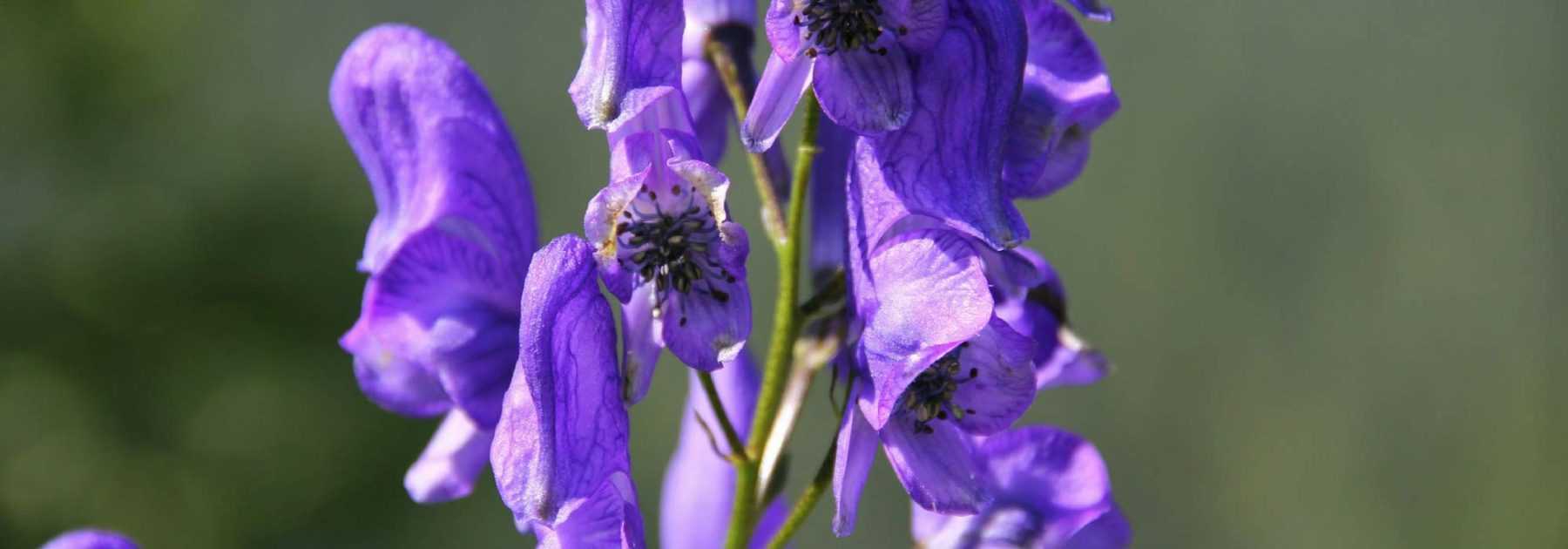
Aconite: Planting, Care and Dividing
Contents
Aconite in a Few Words
- Aconite or Aconitum napellus is a reliable and floriferous perennial plant for partial shade
- Its flowering, similar to delphiniums, lasts from June to October
- It boasts one of the most beautiful blue hues in the garden
- With its architectural form, its flower stems can reach up to 1.50m in height
- Hardy and easy to grow in beds or mixed borders
Our expert's word
Monkshood or ‘Jupiter’s Helmet’ is a perennial plant with abundant and long-lasting blooms. Often associated with poison, Monkshood suffers from a bad reputation due to its legendary toxicity, which earned it the nickname “Wolf’s Bane” (Aconitum vulparia).
Widely used today in homeopathy (particularly Aconitum napellus or Monkshood), it remains unjustly overlooked in our gardens.
Majestic yet delicate, its tall flower spikes, sometimes reaching nearly 1.50m, stand proudly above beautifully lobed foliage, displaying spikes of mostly blue flowers (Aconitum carmichaelii), as well as white or yellow varieties, blooming from June to October depending on the species.
Behind the apparent fragility of its flowers lies a highly robust and hardy plant (-15°C). This elegant perennial is easy to grow in all climates and thrives in moist, rich soil, preferably in partial shade.
Monkshood is invaluable for adding vertical accents and focal points in the back of borders or along edges. It pairs effortlessly with other reliable, floriferous perennials in opulent summer displays. When cut, its inflorescences make charming rustic bouquets.
Its lush foliage and generous flower spikes will bring a vibrant and striking touch to the garden. Discover our beautiful Monkshood collection, from the most essential to the rarest varieties!
Description and botany
Botanical data
- Latin name Aconitum
- Family Ranunculaceae
- Common name Casque de Jupiter
- Flowering mai à octobre
- Height 0,60 à 1,50 m
- Exposure Soleil, mi-ombre
- Soil type Fertile
- Hardiness -15°C
The Aconitum genus contains over 100 species or hybrid cultivars, including perennials and biennials that grow wild in the damp mountain meadows of Europe and Asia. Aconitum or “Monkshood”, sometimes mistakenly called “Wolf’s Bane”, is a beautiful herbaceous perennial belonging to the Ranunculaceae family, like its cousin the Delphinium.
Among the most common in our gardens are:
Aconitum napellus, also known as Monkshood, with tall indigo blue spikes, Aconitum carmichaelii, as well as hybrids like Aconitum x cammarum. Some species like Aconitum volubile are climbing and can reach up to 2 m in height.
Aconitum is a perennial plant that often takes one to three years to become properly established, but once settled, it develops from a fleshy to tuberous rootstock from which emerges in spring a superb deciduous and erect clump formed of stems that are sometimes quite woody, slightly hairy, and more or less twining.
Its habit is somewhat sprawling. It stands 50 cm to 1.50 m tall when in flower, with a spread of 30 to 50 cm at maturity, depending on the species.
Aconitum is highly toxic in all its parts, and one of the most deadly plants in our flora if roots are ingested, though poisoning is extremely rare unless one consumes its roots, which even animals avoid!
Very floriferous, this perennial always stands out in a garden. Its upright stems bear above the foliage, from May to October, depending on the species, large airy spikes adorned with numerous flowers. These curious hooded flowers, with sepals 3 to 5 cm long, are grouped in racemes or highly branched terminal panicles 30 to 60 cm long, at the ends of the branches.
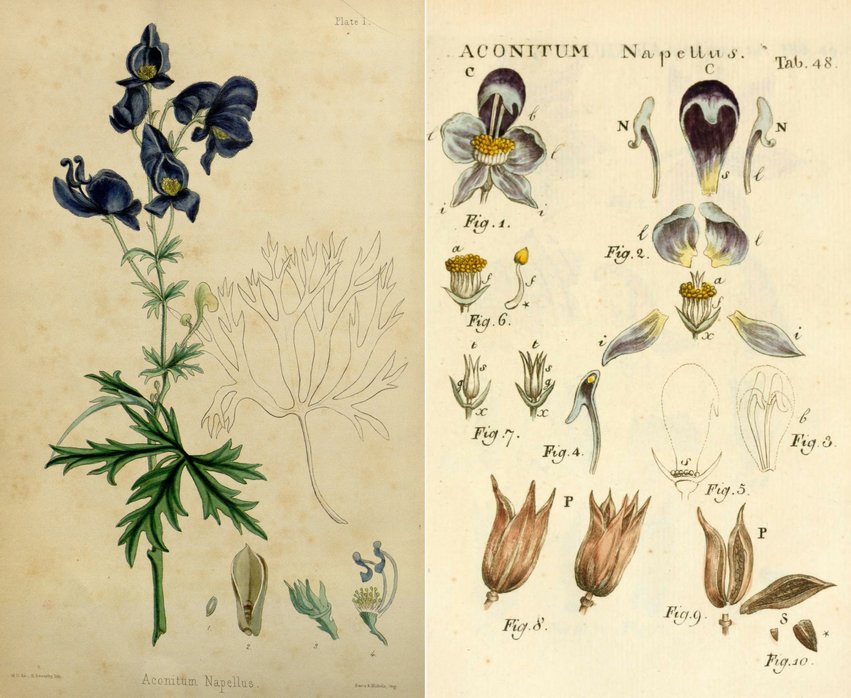
Botanical plates of Aconitum napellus detailing the plant, its flower and seed capsule.
Composed of 5 satiny sepals, slightly upturned at the edges, and numerous contrasting stamens, the flowers take on the original form of an antique helmet, hence the nickname “Monkshood”.
From deep violet-blue, to steely blue veined with ultramarine, through lavender blue and indigo, Aconitum counts among the most beautiful blues in the garden, alongside gentians or delphiniums.
The horticultural cultivar Aconitum x cammarum displays inflorescences whose palette ranges from white to purple, including bicoloured varieties like Aconite ‘Bicolor’ with violet-blue and white flowers.
While the flower spikes mainly bear blue flowers, some varieties are white (Aconitum napellus ‘Scneewittchen’), pink (‘Carneum’), pale yellow (Aconitum anthora), cream (Aconitum septentrionale ‘Ivorine’) and sometimes violet.
They also make very beautiful cut flowers that will last well over a week in a vase. This abundant, nectar-rich flowering attracts bees and pollinating insects.
Dark green in colour, with a glossy surface and pubescent underside, Aconitum foliage is among the most beautiful of perennials. The upright stems bear large deciduous, veined leaves, 5 to 10 cm long. Round or oval, deeply divided into 3 to 7 lobes, they somewhat resemble those of Delphinium.
Aconitum is not a difficult perennial to grow. Very hardy, it fears neither cold nor frost and suits all regions. It grows in any deep, cool, fertile soil that is well-drained, in partially shaded locations, sheltered from strong winds.
This beautiful perennial with its rather architectural habit is perfect at the back of borders or in flower beds, alongside foxgloves, delphiniums, and actaeas, for lush summer displays.
Main species and varieties
There are over a hundred species or hybrid Aconite cultivars. The main selection criteria are flower colour, ranging from indigo blue to lavender through pure white, creamy yellow or even dusky pink, and height (from 0.50m to 1.5m tall), offering great diversity. By carefully combining different Aconite species, you can achieve flowering from spring through autumn!
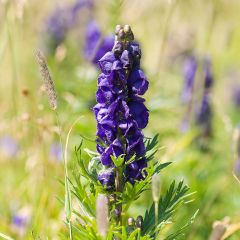
Aconitum napellus
- Flowering time August, September
- Height at maturity 1,20 m
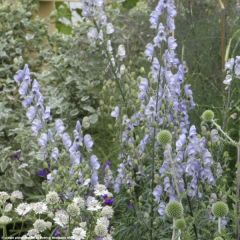
Aconitum Stainless Steel
- Flowering time July to September
- Height at maturity 90 cm
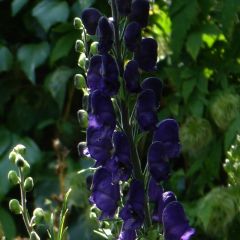
Aconitum henryi Sparks Variety
- Flowering time October, November
- Height at maturity 1,50 m

Aconitum carmichaelii Arendsii
- Flowering time October, November
- Height at maturity 1,20 m
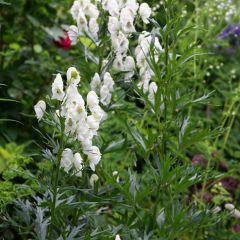
Aconitum napellus subsp. napellus Schneewittchen
- Flowering time August, September
- Height at maturity 1 m

Aconitum cammarum Bicolor
- Flowering time July to September
- Height at maturity 1,20 m
Discover other Aconitum
View all →Available in 1 sizes
Available in 1 sizes
Available in 1 sizes
Available in 2 sizes
Available in 1 sizes
Available in 1 sizes
Available in 3 sizes
Available in 1 sizes
Available in 1 sizes
Available in 2 sizes
Planting
Where to Plant Aconite?
Aconite thrives almost everywhere in France, except perhaps in very windy regions where strong gusts that may bend their stems could threaten this tall perennial.
Retaining its mountain origins, it boasts excellent hardiness, tolerating temperatures as low as -20°C. However, it dislikes winter moisture. It prefers being planted in sheltered spots away from strong winds and in open areas, which encourages the plant to reach its full height.
It favours shady locations, especially in warmer regions, but it’s a highly adaptable plant that can tolerate sun provided the soil remains moist. Its only dislikes are drought and overly poor soils.
As a meadow plant, it loves fertile soils, rich in humus, deep, cool but not waterlogged. The soil must be very well-drained yet consistently moist and never dry out in summer.
More forgiving than delphiniums, it even grows in clay soil and isn’t bothered by slugs, making aconite a great alternative to larkspur in gardens with heavy, damp soil.
It suits all garden styles, beds or mixed borders, planted among shrubs or in light woodland. It adds striking height and vertical interest to any planting scheme. It can also be grown against a wall.
Container cultivation is not recommended for this plant which prefers cool conditions and deep soil.
When to Plant Aconitum?
Planting aconite is best done in spring (March to May) or autumn (October).
How to Plant Aconite
Planting Aconite is straightforward in well-prepared, enriched soil.
Plant potted specimens in groups of 5-6 per m², spaced 30-50cm apart depending on the variety to allow proper growth. For maximum impact in borders, plant in generous numbers.
- Dig a hole twice as wide as the root ball
- Add compost, potting soil and peat when planting
- Plant without burying stems too deeply, keeping the top of the root ball level with the soil surface
- Water thoroughly until established and during dry spells
- Mulch to aid establishment and keep soil cool in summer
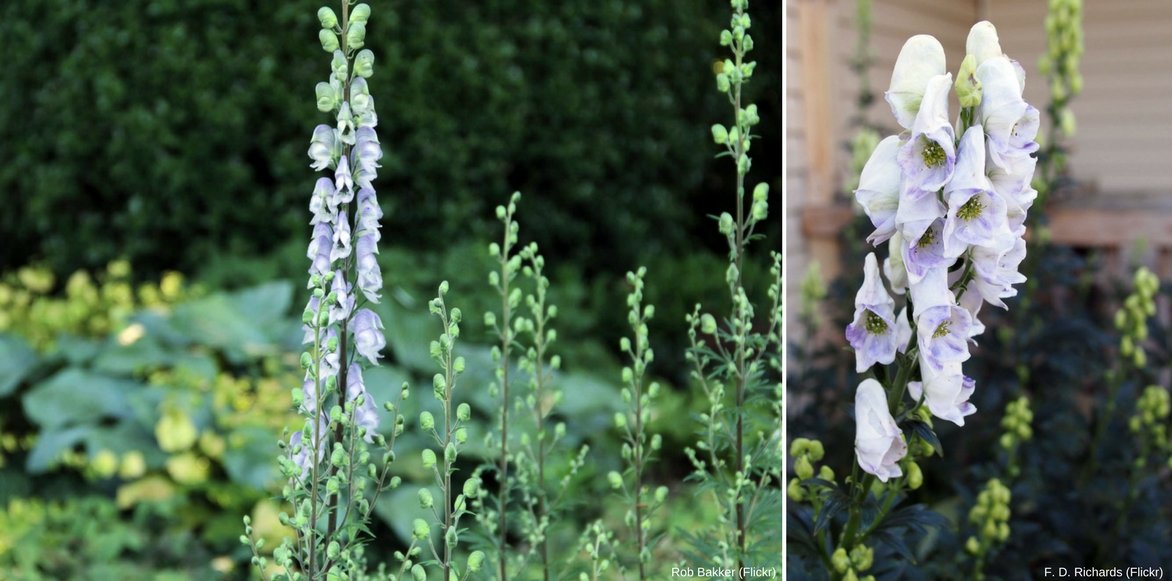
The flower spikes of Aconitum ‘Stainless Steel’ display delicate grey-blue hues.
Maintenance, Pruning and Care
Aconite requires only minimal care to bloom abundantly year after year. This perennial thrives in cool summer conditions and dislikes waterlogged soil in winter.
Apply a mulch to maintain soil moisture and water regularly during dry spells, but avoid overwatering.
Remove spent flowers promptly after blooming to prolong flowering, or leave them to set seed if you wish to encourage self-sown seedlings.
In spring, as new growth emerges, cut back old flower stems to ground level to prevent water from collecting in the hollow stems during winter, which could cause the clumps to rot. Add some compost in spring to maintain soil fertility and moisture retention.
Stake taller varieties if needed using sturdy canes in early spring as growth begins, to provide support when the flower spikes develop.
For older clumps, division helps maintain vigorous flowering. To keep plants healthy, divide every 5 to 7 years in autumn or February when you notice flowering begins to decline.
Diseases and potential pests
Aconite is a hardy perennial that offers excellent resistance to diseases as well as pests.
Slugs aren’t particularly fond of it, unlike delphiniums!
It only fears drought and excess water.
In cases of excessive moisture and in overly heavy soil, it can be affected by white rot, a disease (verticillium wilt) that causes root decay. This is why, as a preventive measure, it is essential to plant it in a location where water is unlikely to stagnate. Take care not to bury its stems too deeply during planting to avoid this type of fungal disease, which thrives in waterlogged soils.
Good growing conditions often prevent these severe attacks.
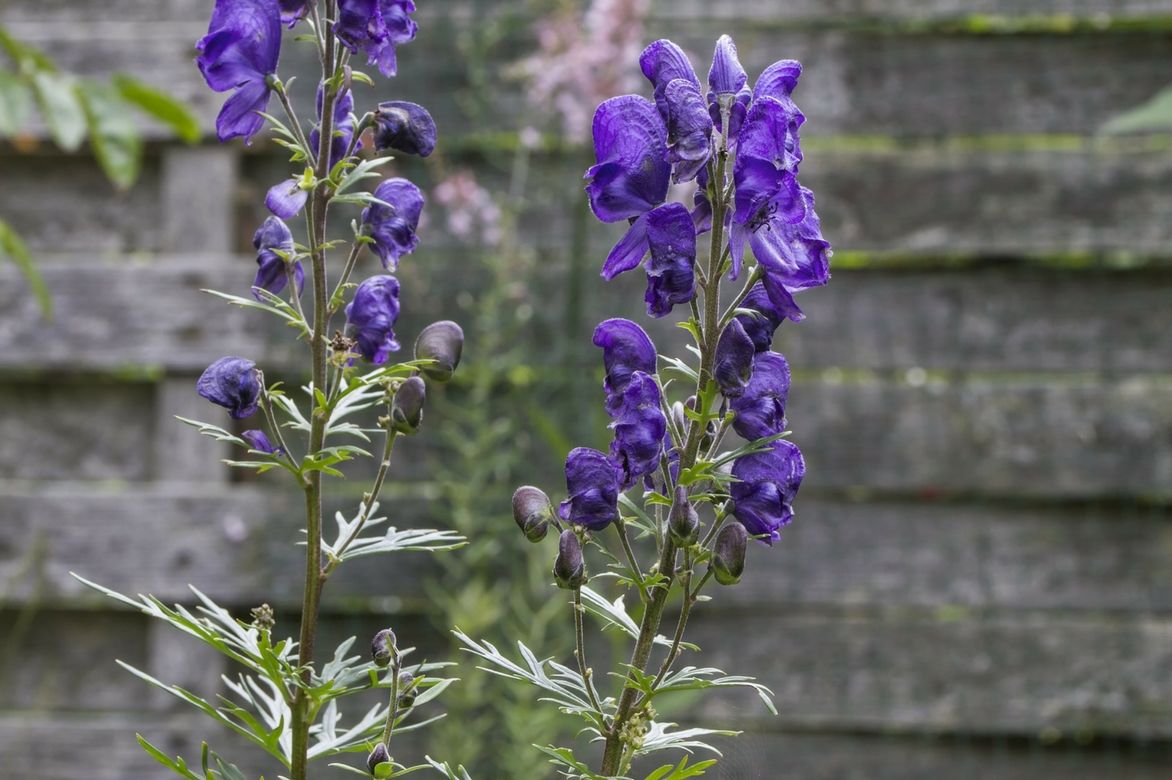
Propagating Aconites: Sowing and Division
Sowing is possible (after stratification, meaning a prior cold period) but results are very unpredictable. Seeds are collected in autumn, kept in the fridge during winter, and sown in spring under a cold frame – unless you’ve cut all the flower stalks, in which case you’ll need to buy them in packets. However, your seedlings won’t flower until the following year. There are easier methods!
You can propagate Aconite by dividing the tuberous clump, even though it spreads naturally over time. Aconite plants lose vigour as they age: after 5 years, clumps become less floriferous and sometimes weaker. Don’t hesitate to divide the plants every 5 to 7 years, in autumn or very early spring, if you want to maintain their vitality.
Dividing Aconite
- Lift the plant with a spade
- Divide into several sections, each with both roots and shoots
- Replant the largest tubers immediately
- Water thoroughly and regularly to encourage establishment
Combining Aconitum in the Garden
Monkshood blends seamlessly into any setting. Exceptionally easy to pair, it even serves as inspiration for creating a naturalistic garden with low-maintenance plants.
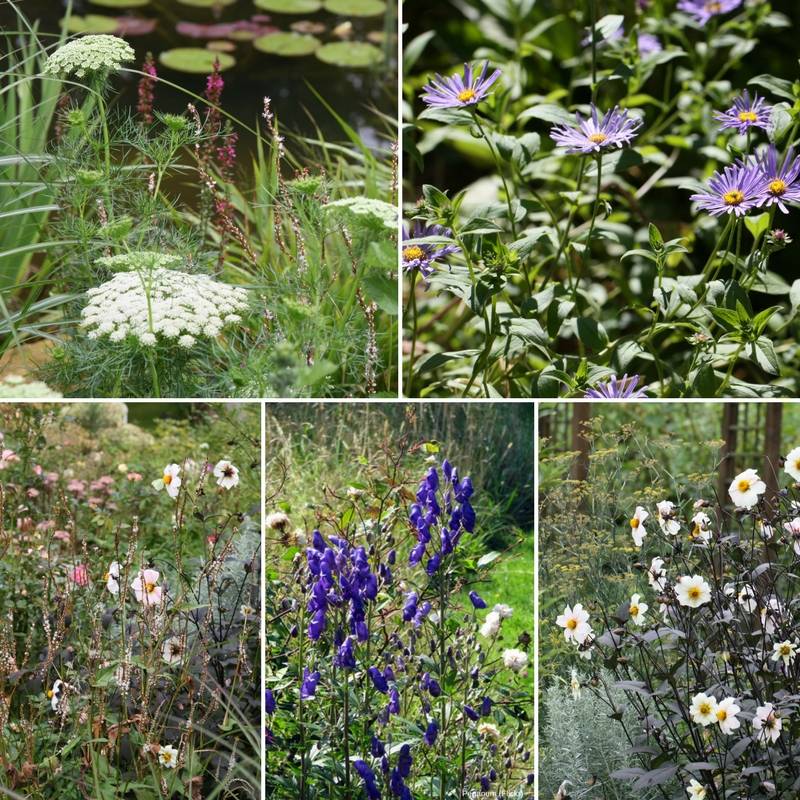
An example of natural pairing: Amni visnaga ‘The Giant’ – Aster frikartii ‘Monch’ – Persicaria amplexicaulis ‘Alba’ – Aconitum carmichaelii ‘Arendsii’ – Foeniculum vulgare ‘Giant Bronze’ – Dahlia ‘Twining’s After Eight’
It forms beautiful bushes at the back of partially shaded borders, and is equally stunning as a bedding plant. It can be exuberant or more understated. The vertical dimension it adds helps structure borders like natural woodland edge scenes.
A staple of herbaceous borders and cottage gardens with rustic charm or prairie-style gardens, it’s cherished for its majestic flower spikes in white, pink, yellow, but most often an incredible blue.
It accompanies the flowering of delphiniums and like them, it’s essential for blue gardens.
Blue/gold, cream/soft orange, Monkshood is perfect for playing with contrasts, shades and gradients, transforming a border into a remarkable impressionist painting. The deep violet-blue spikes of Aconitum napellus contrast beautifully with pale yellow achilleas.
The white-flowered Aconitum napellus ‘Scneewittchen’ is a classic for white gardens where it will grow alongside Echinacea ‘Green Jewel’ and foxgloves ‘Snow Thimble’.

An example of refined pairing: Rose ‘Blush Noisette’ grown as a shrub – Selinum wallichianum – Aconitum napellus ‘Schneewittchen’ – Foeniculum vulgare ‘Giant Bronze’ – Digitalis purpurea ‘Snow Timble’.
At the back of borders, it will keep company with tall hardy geraniums, dahlias or ornamental grasses like miscanthus.
In summer, it combines in lush borders with masterworts, black-eyed Susans, speedwells, phlox, and cosmos. Its spectacular foliage and summer flower spikes pair beautifully with Oriental poppies.
Later varieties (Aconitum carmichaelii Arendsii, Aconitum Spark’s Variety) combine with asters, Japanese anemones and chrysanthemums in beautiful autumn displays.
They also look stunning against the autumn foliage of Persian ironwood or sweetgums.
Also discover our article: Monkshood: 7 ideas for garden pairings
Useful resources
- The most beautiful Aconite collection is right here with us!
- Subscribe!
- Contents


































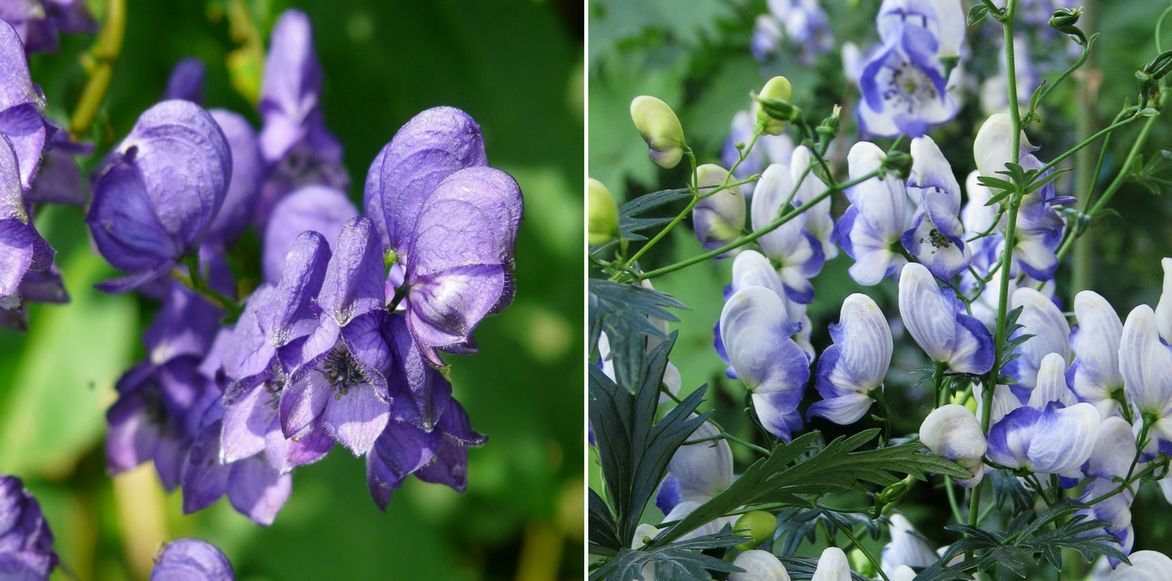

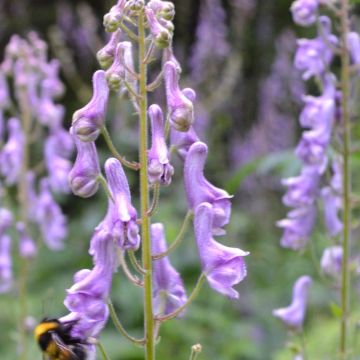
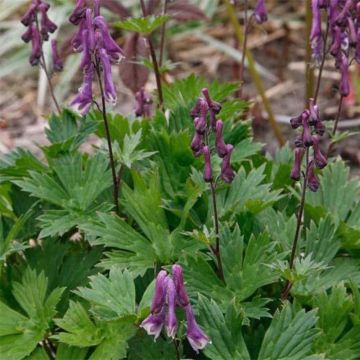
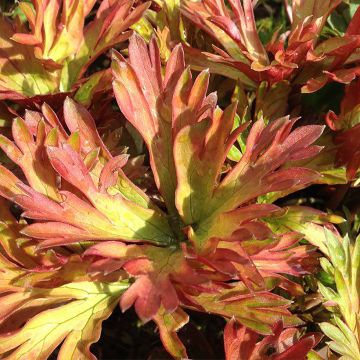

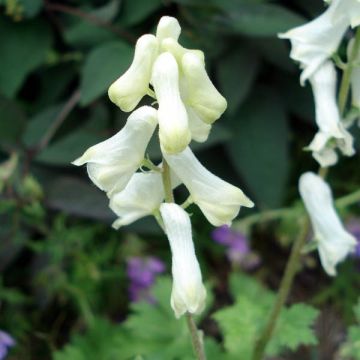

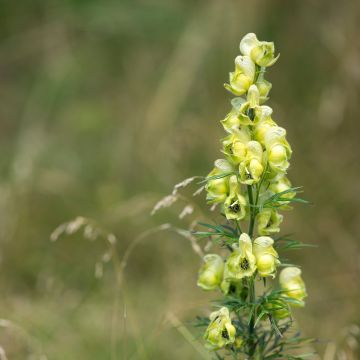
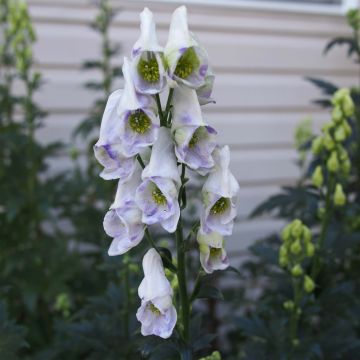
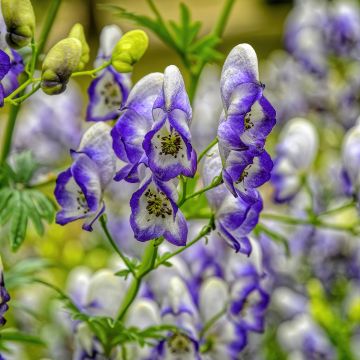
Comments